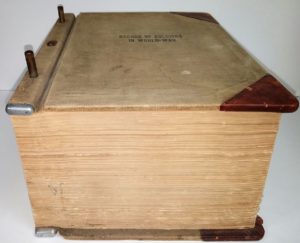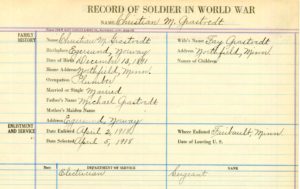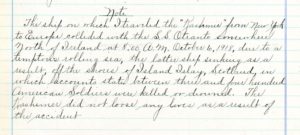We at the DHC are pleased to announce that we have completed the digitization of an incredibly rich resource detailing the service of Rice County servicemen during World War I.

Record of Soldiers in World War ledger, Rice County Historical Society collection, 2010.119.04
This Record of Soldiers in the World War ledger was compiled by the Rice County War Records Committee during and after the war. They intended to keep a record of every man from the county who served using a two-sided form – although we have found that some forms are more filled out than others. As you can imagine, capturing the information for so many people was a massive undertaking and we can see the results in the more than 5″ tall ledger you see here.
To ready this book for the DHC, a team of staff and volunteers spent countless hours scanning every page with writing on it, and also transcribing all the unique text on the pages. We transcribed every word so that the digitized book is full-text searchable on both the DHC’s CONTENTdm database as well as on completely unrelated search engines. A team of DHC staff and volunteers created over 2,000 scans (2,084 to be exact) and transcribed 2,028 pages. None of this would have been possible without the help from these community volunteers and students from St. Olaf College:
Wally Ahrens
Ryleigh Beers
Thea Brenner
Kelly Cheng
Teagan Letscher
Anna Moen
Tetyana Samiliv
Danielle Sovereign
Danica Vin Ly
Jordan Weaver
Each page recorded personal and family information as well as enlistment and service details. In this way, the book is not simply a “war record” book – it can serve as a resource for family historians and genealogists, as well as researchers looking for details on occupations, demographics, residences and migration, and more.

Excerpt from the record of Christian M. Grastvedt of Northfield in the Record of Soldiers book.
Occasionally, more detailed stories can be found on the reverse side of a form, including the battles the man participated in, whether or not he was wounded, and sometimes if he died. A few of the records include the soldier’s first-person account of experiences copied from his letters.

First-person note from James Alfred Sheeran of Faribault about his experiences at sea on the way to France during the war. As copied into his page in the Record of Soldiers book.
“The ship on which I traveled,” he wrote, “collided with the S.S. Otranto somewhere north of Ireland … accounts state between three and four hundred American Soldiers were killed or drowned.” Luckily, no one on his ship lost their lives due to the accident. Details like this can be found in many of the pages within the Record of Soldiers book.
Overall, this massive ledger provides a fascinating cross-section view on the variety of ways Rice County men served in the military during World War I. Reading it, you can see how many enlisted compared to how many were drafted. You can see the varied backgrounds each of them came from – yes, many were farmers, but there were also clerks, teachers, plumbers, dentists, mechanics, even a chiropractor. You can see the many departments they served in – Aviation, Signal Corps, Machine Gun, Field or Coast Artillery, Infantry, Engineers, Pioneer Infantry, Navy, and more. You can read details about their promotions, transfers, and movement throughout the U.S. in different training camps as well as all over France. You can see lists of battles they participated in and times they received medical care.
For all of the information found within this book, however, I am always left with a desire to learn more. Why did he get medical care? How did his wife feel about him enlisting and leaving her alone with their baby? Why was he rejected only 5 days after being drafted? What did he do once he returned home? How did he feel about his service if he only served 2 months and never went “across”? What memories did he hold on to long after the war ended?
That’s the beauty of primary source documents like this – they lead you down more paths to research and explore. I hope you enjoy digging into this document as much as we did while preparing it for you!

What a project! Congratulations. A valuable contribution to local history!